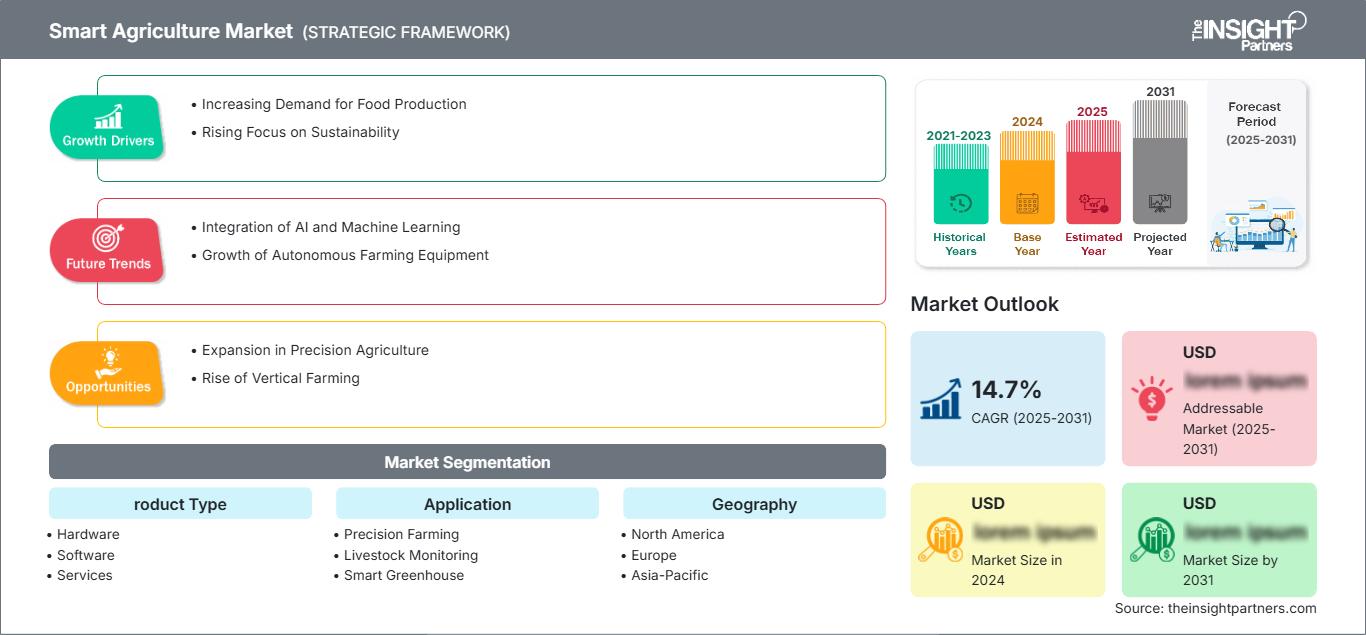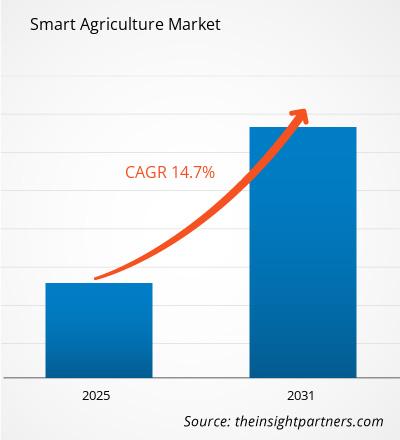Der Markt für intelligente Landwirtschaft wird voraussichtlich zwischen 2025 und 2031 eine durchschnittliche jährliche Wachstumsrate (CAGR) von 14,7 % verzeichnen, wobei die Marktgröße von XX Millionen US-Dollar im Jahr 2024 auf XX Millionen US-Dollar im Jahr 2031 anwachsen wird.
Der Bericht ist nach Produkttyp (Hardware, Software und Dienstleistungen) und Anwendung (Präzisionslandwirtschaft, Viehbestandsüberwachung, intelligentes Gewächshaus und andere) segmentiert. Die globale Analyse ist weiter nach Regionen und wichtigen Ländern aufgeschlüsselt. Der Bericht bietet den Wert in USD für die oben genannte Analyse und Segmente.
Zweck des Berichts
Der Bericht „Markt für intelligente Landwirtschaft“ von The Insight Partners zielt darauf ab, die aktuelle Situation und das zukünftige Wachstum sowie die wichtigsten treibenden Faktoren, Herausforderungen und Chancen zu beschreiben. Dies bietet verschiedenen Geschäftspartnern Einblicke, wie beispielsweise:
- Technologieanbieter/-hersteller: Um die sich entwickelnde Marktdynamik zu verstehen und die potenziellen Wachstumschancen zu kennen, damit sie fundierte strategische Entscheidungen treffen können.
- Investoren: Um eine umfassende Trendanalyse hinsichtlich der Marktwachstumsrate, der finanziellen Marktprognosen und der Chancen entlang der Wertschöpfungskette durchzuführen.
- Regulierungsbehörden: Um Richtlinien und Überwachungsaktivitäten auf dem Markt zu regulieren, mit dem Ziel, Missbrauch zu minimieren, das Vertrauen der Investoren zu wahren und die Integrität und Stabilität des Marktes aufrechtzuerhalten.
Marktsegmentierung für intelligente Landwirtschaft: Produkttyp
- Hardware
- Software
- Dienstleistungen
Anwendung
- Präzisionslandwirtschaft
- Viehüberwachung
- Intelligentes Gewächshaus
- Sonstiges.
Sie erhalten kostenlos Anpassungen an jedem Bericht, einschließlich Teilen dieses Berichts oder einer Analyse auf Länderebene, eines Excel-Datenpakets sowie tolle Angebote und Rabatte für Start-ups und Universitäten.
Markt für intelligente Landwirtschaft: Strategische Einblicke

-
Holen Sie sich die wichtigsten Markttrends aus diesem Bericht.Dieses KOSTENLOSE Beispiel umfasst Datenanalysen, die von Markttrends bis hin zu Schätzungen und Prognosen reichen.
Wachstumstreiber für den Markt für intelligente Landwirtschaft
- Steigende Nachfrage nach Nahrungsmittelproduktion: Angesichts des rasanten Wachstums der Weltbevölkerung ist die Nachfrage nach Nahrungsmitteln so hoch wie nie zuvor. Intelligente Landwirtschaftslösungen, darunter Präzisionslandwirtschaft, IoT-Sensoren und automatisierte Maschinen, tragen dazu bei, landwirtschaftliche Praktiken zu optimieren, um diesen Bedarf zu decken. Diese Technologien ermöglichen es Landwirten, Ernteerträge zu steigern, Abfall zu reduzieren und das Ressourcenmanagement zu verbessern. So wird dem Bedarf an effizienteren Nahrungsmittelproduktionssystemen zur Ernährung der wachsenden Weltbevölkerung Rechnung getragen.
- Nachhaltigkeit rückt in den Fokus: Nachhaltigkeit wird aufgrund von Klimawandel, Ressourcenerschöpfung und Umweltzerstörung zu einem wichtigen Anliegen in der Landwirtschaft. Intelligente Landwirtschaftstechnologien helfen Landwirten, nachhaltigere Praktiken einzuführen, indem sie den Wasserverbrauch optimieren, den Chemikalieneinsatz reduzieren und Abfall minimieren. Technologien wie Drohnen, Bodensensoren und automatisierte Bewässerungssysteme ermöglichen ein effizienteres Ressourcenmanagement und fördern den Umweltschutz bei gleichbleibender Produktivität.
Zukünftige Trends im Markt für intelligente Landwirtschaft
- Integration von KI und maschinellem Lernen: Künstliche Intelligenz (KI) und maschinelles Lernen (ML) werden zunehmend in intelligente Landwirtschaftssysteme integriert. Diese Technologien analysieren riesige Datenmengen, die von Sensoren, Drohnen und Satelliten gesammelt wurden, und liefern Landwirten umsetzbare Erkenntnisse. KI und ML können Wettermuster vorhersagen, Pflanzpläne optimieren, Schädlinge erkennen und das Pflanzenmanagement verbessern, wodurch die Entscheidungsfindung und die allgemeine Effizienz der Landwirtschaft verbessert werden.
- Wachstum autonomer landwirtschaftlicher Geräte: Die Einführung autonomer Fahrzeuge und Maschinen ist ein wachsender Trend in der intelligenten Landwirtschaft. Traktoren, Erntemaschinen und Drohnen, die mit GPS und Sensoren ausgestattet sind, werden immer häufiger. Diese autonomen Systeme senken die Arbeitskosten, verbessern die Genauigkeit und ermöglichen einen 24/7-Betrieb. So können Landwirte Feldarbeiten wie Pflanzen, Düngen und Ernten mit minimalem menschlichen Eingriff optimieren, die Produktivität steigern und die Betriebskosten senken.
Marktchancen für intelligente Landwirtschaft
- Expansion der Präzisionslandwirtschaft: Die Präzisionslandwirtschaft ist eine der größten Chancen für die intelligente Landwirtschaft. Durch den Einsatz fortschrittlicher Technologien wie GPS-gesteuerten Traktoren, Drohnen und Bodensensoren können Landwirte ihre Pflanzen mit einem beispiellosen Detaillierungsgrad überwachen und bewirtschaften. Dies kann zu höheren Ernteerträgen, weniger Abfall und einer effizienteren Nutzung von Betriebsmitteln wie Wasser und Düngemitteln führen und so ein erhebliches Wachstumspotenzial im Bereich der Agrartechnologie schaffen.
- Aufstieg der vertikalen Landwirtschaft: Vertikale Landwirtschaft, ein innovativer Ansatz, der den Anbau von Pflanzen in gestapelten Schichten oder kontrollierten Umgebungen ermöglicht, bietet erhebliche Chancen für intelligente Landwirtschaftstechnologien. Automatisierte Systeme für Beleuchtung, Temperatur, Bewässerung und Nährstoffzufuhr sind entscheidend für die Maximierung von Platz und Effizienz. Angesichts der zunehmenden Urbanisierung kann die vertikale Landwirtschaft eine Lösung für die lokale Nahrungsmittelproduktion bieten, die Transportkosten senken und das ganze Jahr über frische Produkte gewährleisten.
Regionale Einblicke in den Markt für intelligente Landwirtschaft
Die Analysten von The Insight Partners haben die regionalen Trends und Faktoren, die den Markt für intelligente Landwirtschaft im Prognosezeitraum beeinflussen, ausführlich erläutert. In diesem Abschnitt werden auch die Marktsegmente und die geografische Lage in Nordamerika, Europa, dem asiatisch-pazifischen Raum, dem Nahen Osten und Afrika sowie Süd- und Mittelamerika erörtert.
Umfang des Marktberichts zur intelligenten Landwirtschaft
| Berichtsattribut | Einzelheiten |
|---|---|
| Marktgröße in 2024 | US$ XX million |
| Marktgröße nach 2031 | US$ XX Million |
| Globale CAGR (2025 - 2031) | 14.7% |
| Historische Daten | 2021-2023 |
| Prognosezeitraum | 2025-2031 |
| Abgedeckte Segmente |
By Produkttyp
|
| Abgedeckte Regionen und Länder |
Nordamerika
|
| Marktführer und wichtige Unternehmensprofile |
|
Dichte der Marktteilnehmer im Bereich intelligente Landwirtschaft: Verständnis ihrer Auswirkungen auf die Geschäftsdynamik
Der Markt für intelligente Landwirtschaft wächst rasant. Die steigende Nachfrage der Endverbraucher ist auf Faktoren wie veränderte Verbraucherpräferenzen, technologische Fortschritte und ein stärkeres Bewusstsein für die Produktvorteile zurückzuführen. Mit der steigenden Nachfrage erweitern Unternehmen ihr Angebot, entwickeln Innovationen, um den Bedürfnissen der Verbraucher gerecht zu werden, und nutzen neue Trends, was das Marktwachstum weiter ankurbelt.

- Holen Sie sich die Markt für intelligente Landwirtschaft Übersicht der wichtigsten Akteure
Wichtige Verkaufsargumente
- Umfassende Abdeckung: Der Bericht analysiert umfassend Produkte, Dienstleistungen, Typen und Endnutzer des Marktes für intelligente Landwirtschaft und bietet einen ganzheitlichen Überblick.
- Expertenanalyse: Der Bericht basiert auf dem umfassenden Verständnis von Branchenexperten und Analysten.
- Aktuelle Informationen: Der Bericht gewährleistet Geschäftsrelevanz durch die Berichterstattung über aktuelle Informationen und Datentrends.
- Anpassungsoptionen: Dieser Bericht kann an spezifische Kundenanforderungen angepasst werden und passt sich optimal an die Geschäftsstrategien an.
Der Forschungsbericht zum Markt für intelligente Landwirtschaft kann daher dazu beitragen, die Branchensituation und die Wachstumsaussichten zu entschlüsseln und zu verstehen. Obwohl es einige berechtigte Bedenken geben kann, überwiegen die Vorteile dieses Berichts tendenziell die Nachteile.
- Historische Analyse (2 Jahre), Basisjahr, Prognose (7 Jahre) mit CAGR
- PEST- und SWOT-Analyse
- Marktgröße Wert/Volumen – Global, Regional, Land
- Branchen- und Wettbewerbslandschaft
- Excel-Datensatz
Aktuelle Berichte
Erfahrungsberichte
Grund zum Kauf
- Fundierte Entscheidungsfindung
- Marktdynamik verstehen
- Wettbewerbsanalyse
- Kundeneinblicke
- Marktprognosen
- Risikominimierung
- Strategische Planung
- Investitionsbegründung
- Identifizierung neuer Märkte
- Verbesserung von Marketingstrategien
- Steigerung der Betriebseffizienz
- Anpassung an regulatorische Trends






















 Kostenlose Probe anfordern für - Markt für intelligente Landwirtschaft
Kostenlose Probe anfordern für - Markt für intelligente Landwirtschaft